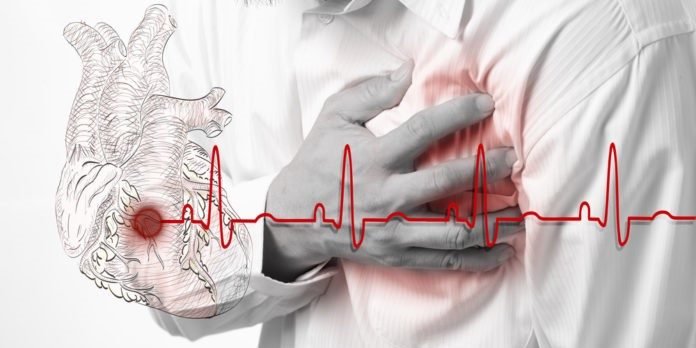Cardiovascular diseases
What are cardiovascular diseases?
The term “cardiovascular disease” is not always used uniformly. In the broadest sense, it includes all diseases that affect the heart and blood circulation. Some of the most common cardiovascular diseases are briefly described below.

Hypertension (high blood pressure) and hypotension (low blood pressure)
Blood pressure values are expressed in two numbers: the upper value (systolic) corresponds to the blood pressure when a pulse wave flows through the arteries, the lower value (diastolic) corresponds to the pressure between heartbeats. The ideal blood pressure for an adult is considered to be around 120/80 mmHg. However, the blood pressure value depends on age and gender, so it tends to rise slightly with increasing age and women normally have slightly lower values than men. Hypertension (high blood pressure) can be a risk factor for secondary diseases such as arteriosclerosis (hardening of the arteries) and is therefore feared and often treated with medication. Hypotension is less serious; as long as there are no symptoms, low blood pressure is not serious and is quite normal, especially for younger women. However, if low blood pressure causes symptoms, these are not life-threatening but can be very unpleasant for those affected (dizziness, tiredness, lack of energy, headaches, etc.). More rarely, however, it can also lead to dangerous situations (e.g. circulatory collapse).

Arteriosclerosis (hardening of the arteries)
Arteriosclerosis (more precisely: atherosclerosis) is a progressive change in the arterial blood vessels over the years, in which so-called plaques are deposited on the vessel walls. The vessel walls “calcify”, lose their elasticity and the vessel diameter narrows. As a result, the blood can no longer flow unhindered or even the dreaded complete blockage of a vessel can occur. The most common consequences of vascular occlusion due to arteriosclerosis include heart attack and stroke (also known as cerebral stroke, cerebral insult, cerebral infarction).
Angina pectoris (narrowing of the heart or chest)
Angina pectoris is a sudden feeling of tightness and/or pain in the chest caused by a circulatory disorder of the heart muscle. The typical symptoms are squeezing, pressing pain in the region of the heart, a feeling of tightness in the chest and breathing difficulties. The symptoms appear after exertion, stress, eating a lot, etc. They disappear again after a few minutes of rest and/or after taking nitroglycerin.

Myocardial infarction (heart attack)
In a myocardial infarction, a blood clot (thrombus) blocks a coronary artery, which means that part of the heart muscle (myocardium) is no longer supplied with oxygen and dies. Depending on the area affected, this can lead to a life-threatening situation. The heart muscle can only perform at a reduced level. The pain behind the breastbone, which is usually very severe and constricting, can radiate to the back, stomach, left arm or neck. The pain is often accompanied by anxiety, shortness of breath and nausea. However, the symptoms can also look completely different, especially in women! A heart attack is always an emergency situation, which is why emergency medical help should be called as soon as possible, even at the slightest suspicion! The faster treatment can begin, the better the prognosis.
Coronary heart disease (coronary artery disease)
Coronary heart disease affects the coronaries (coronary arteries). The coronaries supply the heart muscle with oxygen and nutrients. Plaques in the coronary arteries lead to their narrowing (arteriosclerosis), which means that the heart muscle is no longer supplied with sufficient oxygen and nutrients. Various symptoms can occur, ranging from pain and tightness in the chest (angina pectoris) to a heart attack or sudden cardiac death.

Heart failure (cardiac insufficiency)
A distinction is made between left heart failure, right heart failure and global heart failure (affects the “whole” heart). The heart muscle is no longer able to provide its full pumping capacity. This can result in a backlog of blood, which leads to the formation of oedema (water retention in the tissue) in the lungs (left heart failure) or in the legs (right heart failure).
Cardiac arrhythmias
There are various cardiac arrhythmias; briefly explained, these are heartbeats that are too slow (bradycardia), too fast (tachycardia) or irregular (arrhythmia) or extra beats (extrasystoles). These can have a variety of causes and can be harmless or pathological. The normal heart rate of an adult at rest is between 60 and 80 regular beats per minute. Cardiac arrhythmias can originate in the ventricle or the atrium.
Cardiovascular disease: prevention and treatment

Depending on the disease, there are of course various medications as well as invasive or surgical measures that can help, but are always associated with side effects and complications. Prevention is certainly always the better option. But how? Since the 1950s, the hypothesis of an American nutrition researcher, according to which an elevated cholesterol level leads to hardening of the arteries and thus favours heart attacks, has been widely disseminated. This is despite the fact that this hypothesis has by no means been proven. Nevertheless, the hypothesis persists and statins (blood fat reducers) are prescribed en masse in the fight against the dreaded plaques, although they also have many side effects. More and more voices are saying that high sugar consumption could be to blame and that high cholesterol is overrated.
Nutrition
Either way, a balanced diet with plenty of fresh fruit and vegetables and wholemeal products (organic quality) should be taken into account for prevention. Sugar consumption should be kept to a minimum, which is not so easy, as many products contain large amounts of sugar, even where you would not expect it! Ready-made or semi-finished products should therefore also be avoided. Plenty of exercise and as little negative stress (distress) as possible are just as important. It is also very important to reduce risk factors such as obesity, stop smoking or properly “adjust” diabetes.

Omega-3 fatty acids
It is known that omega-3 fatty acids, which are mainly found in oily sea fish and krill, can reduce the risk of sudden cardiac death and protect against other cardiovascular diseases. Various effects of EPA and DHA (the most biologically active omega-3 fatty acids) have been demonstrated in human studies. They have an anti-arrhythmic effect both at the level of the atrium and the ventricle, they stabilise unstable vascular districts that can otherwise cause angina pectoris and myocardial infarction (“unstable plaques”), they slow down the progression of changes in the coronary vessels and reduce triglyceride levels, which can pose a risk of thrombosis or arteriosclerosis. They also have a preventive effect against coronary heart disease, promote blood circulation and inhibit platelet aggregation (white blood cells sticking together, which can lead to thromboses and embolisms). Numerous other positive effects on vascular function, blood pressure and inflammatory mediators have been confirmed.
Vitamin K2
The main task of vitamin K2 is to ensure that calcium does not remain in the blood, where it can be deposited on the vessel walls (arteriosclerosis), but is stored in the bones, where it is needed for healthy bones. Vitamin K is also involved in blood clotting (coagulation). Vitamin K2 is formed by microorganisms, including the bacteria in the intestinal flora, and can be absorbed directly via the intestinal cells. Raw sauerkraut, butter, egg yolk, liver, some types of cheese and the fermented soya product natto are also sources of vitamin K2.
A healthy diet and the importance of vital substances
A balanced and healthy diet that ensures a supply with all the vital substances that are important for physical health can prevent many diseases and support the body in the event of illness. As nutrition is hardly possible in this day and age, in certain cases nutritional supplements can offer help in certain cases.